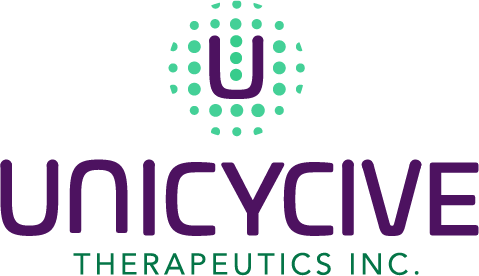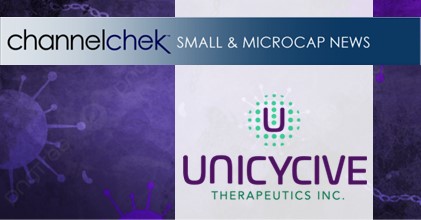
Research News and Market Data on UNCY
February 20, 2025 7:00am EST Download as PDF
Combination therapy with oxylanthanum carbonate plus tenapanor led to greater reductions in urinary phosphate excretion than either drug alone
LOS ALTOS, Calif., Feb. 20, 2025 (GLOBE NEWSWIRE) — Unicycive Therapeutics, Inc. (Nasdaq: UNCY), a clinical-stage biotechnology company developing therapies for patients with kidney disease, today announced the publication of preclinical data describing the benefits of combination treatment of oxylanthanum carbonate (OLC) and tenapanor on phosphate management in the American Society of Nephrology (ASN) journal, Kidney360.
The publication, entitled “Combination Oxylanthanum Carbonate and Tenapanor Lowers Urinary Phosphate Excretion in Rats,” examines the potential synergistic benefits of a combination of OLC, a phosphate binder, with tenapanor, a sodium/hydrogen exchanger 3 (NHE3) inhibitor, on urinary phosphate excretion. Data demonstrated sizeable reductions in urinary phosphate excretion (a proxy for intestinal phosphate absorption) in response to both OLC monotherapy and the combination of OLC with tenapanor.
“With approximately 75% of patients receiving maintenance dialysis failing to meet serum phosphate targets set by international Kidney Disease Improving Global Outcomes (KDIGO) guidelines, we must explore new approaches to improve control of hyperphosphatemia” said Glenn M. Chertow, M.D., M.P.H., Professor of Medicine, Stanford University School of Medicine. “Based on the results of this pre-clinical study, we believe that OLC, an investigational phosphate binder, when used alone or in combination with tenapanor, could improve control of hyperphosphatemia in patients receiving maintenance dialysis who are either unresponsive to currently available phosphate binders or intolerant to their associated adverse effects, high pill burden, and poor palatability.”
“We’re excited by these preclinical data showing a synergistic treatment effect from the combination of OLC and tenapanor. OLC, with its low pill burden and more palatable formulation, could complement tenapanor, significantly enhancing patient adherence and clinical outcomes,” said Shalabh Gupta, MD, Chief Executive Officer of Unicycive. “Further studies in patients with end-stage kidney disease and hyperphosphatemia will be required to understand the most effective and best tolerated OLC-containing regimens, as we aim to improve long-term control of hyperphosphatemia and prevent its myriad complications.”
Key Findings:
- Treatment with tenapanor alone (0.15 mg/kg) led to 12.5% lower mean urinary phosphate excretion compared to the vehicle in rats fed a high phosphorus diet.
- A pooled analysis of monotherapy with OLC (0.75%, 1.5%, and 3%) demonstrated a 17.7% reduction in urinary phosphate excretion compared to vehicle.
- Treatment with tenapanor in combination with OLC demonstrated a more pronounced 41.3% reduction in urinary phosphate excretion compared to vehicle.
- The combination of OLC and tenapanor was synergistic and statistically significant (p=0.009 for 0.75% OLC + tenapanor and p=0.010 for 1.5% OLC + tenapanor).
About Oxylanthanum Carbonate (OLC)
Oxylanthanum carbonate is a next-generation lanthanum-based phosphate binding agent utilizing proprietary nanoparticle technology being developed for the treatment of hyperphosphatemia in patients with chronic kidney disease (CKD). OLC has over forty issued and granted patents globally. Its potential best-in-class profile may have meaningful patient adherence benefits over currently available treatment options as it requires a lower pill burden for patients in terms of number and size of pills per dose that are swallowed instead of chewed. Based on a survey conducted in 2022, Nephrologists stated that the greatest unmet need in the treatment of hyperphosphatemia with phosphate binders is a lower pill burden and better patient compliance.1 The global market opportunity for treating hyperphosphatemia is projected to be in excess of $2.28 billion, with the North America accounting for more than $1 billion of that total.2 Despite the availability of several FDA-cleared medications, 75 percent of U.S. dialysis patients fail to achieve the target phosphorus levels recommended by published medical guidelines.3
Unicycive is seeking FDA approval of OLC via the 505(b)(2) regulatory pathway. The NDA submission package is based on data from three clinical studies (a Phase 1 study in healthy volunteers, a bioequivalence study in healthy volunteers, and a tolerability study of OLC in CKD patients on dialysis), multiple preclinical studies, and the chemistry, manufacturing and controls (CMC) data. OLC is protected by a strong global patent portfolio including issued patents on composition of matter with exclusivity until 2031, and with the potential for patent term extension until 2035.
About Hyperphosphatemia
Hyperphosphatemia is a serious medical condition that occurs in nearly all patients with End Stage Renal Disease (ESRD). If left untreated, hyperphosphatemia leads to secondary hyperparathyroidism (SHPT), which then results in renal osteodystrophy (a condition similar to osteoporosis and associated with significant bone disease, fractures and bone pain); cardiovascular disease with associated hardening of arteries and atherosclerosis (due to deposition of excess calcium-phosphorus complexes in soft tissue). Importantly, hyperphosphatemia is independently associated with increased mortality for patients with chronic kidney disease on dialysis. Based on available clinical data to date, over 80% of patients show signs of cardiovascular calcification by the time they become dependent on dialysis.4
Dialysis patients are already at an increased risk for cardiovascular disease (because of underlying diseases such as diabetes and hypertension), and hyperphosphatemia further exacerbates this. Treatment of hyperphosphatemia is aimed at lowering serum phosphate levels via two means: (1) restricting dietary phosphorus intake; and (2) using, on a daily basis, and with each meal, oral phosphate binding drugs that facilitate fecal elimination of dietary phosphate rather than its absorption from the gastrointestinal tract into the bloodstream.
About Unicycive Therapeutics
Unicycive Therapeutics is a biotechnology company developing novel treatments for kidney diseases. Unicycive’s lead drug candidate, oxylanthanum carbonate (OLC), is a novel investigational phosphate binding agent being developed for the treatment of hyperphosphatemia in chronic kidney disease patients on dialysis. Positive pivotal trial results were reported in June 2024 for OLC, and a New Drug Application (NDA) is under review by the U.S. Food and Drug Administration (FDA) with a Prescription Drug User Fee Act (PDUFA) Target Action Date of June 28, 2025. OLC is protected by a strong global patent portfolio including an issued patent on composition of matter with exclusivity until 2031, and with the potential patent term extension until 2035 after OLC approval. Unicycive’s second asset, UNI-494, is a patent-protected new chemical entity in clinical development for the treatment of conditions related to acute kidney injury. UNI-494 has successfully completed a Phase 1 trial. For more information, please visit Unicycive.com and follow us on LinkedIn, X, and YouTube.
Forward-looking statements
Certain statements in this press release are forward-looking within the meaning of the Private Securities Litigation Reform Act of 1995. These statements may be identified using words such as “anticipate,” “believe,” “forecast,” “estimated” and “intend” or other similar terms or expressions that concern Unicycive’s expectations, strategy, plans or intentions. These forward-looking statements are based on Unicycive’s current expectations and actual results could differ materially. There are several factors that could cause actual events to differ materially from those indicated by such forward-looking statements. These factors include, but are not limited to, clinical trials involve a lengthy and expensive process with an uncertain outcome, and results of earlier studies and trials may not be predictive of future trial results; our clinical trials may be suspended or discontinued due to unexpected side effects or other safety risks that could preclude approval of our product candidates; risks related to business interruptions, which could seriously harm our financial condition and increase our costs and expenses; dependence on key personnel; substantial competition; uncertainties of patent protection and litigation; dependence upon third parties; and risks related to failure to obtain FDA clearances or approvals and noncompliance with FDA regulations. Actual results may differ materially from those indicated by such forward-looking statements as a result of various important factors, including: the uncertainties related to market conditions and other factors described more fully in the section entitled ‘Risk Factors’ in Unicycive’s Annual Report on Form 10-K for the year ended December 31, 2023, and other periodic reports filed with the Securities and Exchange Commission. Any forward-looking statements contained in this press release speak only as of the date hereof, and Unicycive specifically disclaims any obligation to update any forward-looking statement, whether as a result of new information, future events or otherwise.
1Reason Research, LLC 2022 survey. Results here.
2 Fortune Business InsightsTM, Hyperphosphatemia Treatment Market, 2023-2030
3 US-DOPPS Practice Monitor, May 2021; http://www.dopps.org/DPM
4 Block GA, Klassen PS, Lazarus JM, Ofsthun N, Lowrie EG, Chertow GM. Mineral metabolism, mortality, and morbidity in maintenance hemodialysis. J Am Soc Nephrol. 2004 Aug;15(8):2208-18. doi: 10.1097/01.ASN.0000133041.27682.A2. PMID: 15284307.
Investor Contacts:
Kevin Gardner
LifeSci Advisors
kgardner@lifesciadvisors.com
Chris Calabrese
LifeSci Advisors
ccalabrese@lifesciadvisors.com
Media Contact:
Rachel Visi
Real Chemistry
redery@realchemistry.com
SOURCE: Unicycive Therapeutics, Inc.

Source: Unicycive Therapeutics, Inc.
Released February 20, 2025
